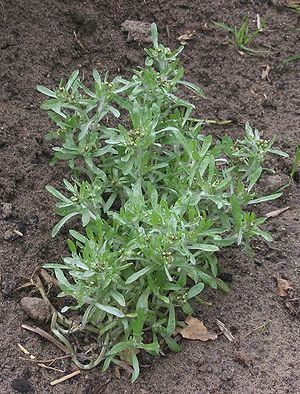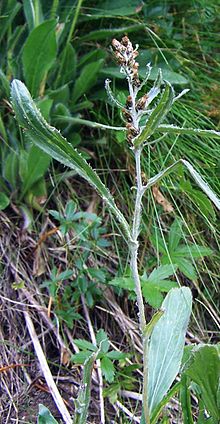Dysentery herbs
| Dysentery herbs | ||||||||||||
|---|---|---|---|---|---|---|---|---|---|---|---|---|

Marsh dysentery ( Gnaphalium uliginosum ) |
||||||||||||
| Systematics | ||||||||||||
|
||||||||||||
| Scientific name | ||||||||||||
| Gnaphalium | ||||||||||||
| L. |
The gnaphalium ( Gnaphalium ) are a plant species from the family of Compositae (Asteraceae).
description
In the genus of the Ruhr herbs one finds mostly annual , but also biennial or perennial herbaceous plants . They reach heights of growth between a few and about 60 centimeters (depending on how far one understands the genus). Most of the species are relatively small, they grow upright or protruding branched and therefore wide and are woolly hairy.
The alternate , sessile leaves are mostly undivided and with entire margins and their shape is oblong oval, lanceolate or oblong spatulate.
The flower heads seated in the terminal and axillary traubigen or ährigen total inflorescences , which are often compressed so that flower clusters or crowded Schirmrispen arise. The flower heads are cylindrical to oval and 2 mm to 4 mm wide. The flower heads contain a few tubular flowers in the middle and several rows of ray-florets , the latter being more numerous, but inconspicuously filiform and hardly longer than the tubular flowers. The flower color is whitish to yellowish or brownish, and the bracts are often a little parchment-like translucent. The achenes are covered with a simple pappus that slopes slightly.
Distribution and location requirements
The Ruhr herbs are cosmopolitan , and in the tropics and subtropics they mainly occur in the mountains.
Most species grow on sandy or stony wasteland, also near rivers or streams.


Systematics and types
The differentiation of the genus of the Ruhr herbs from closely related genera such as the everlasting flowers ( Helichrysum ), cat paws ( Antennaria ), felt herbs ( Filago ) and the pearl paws ( Anaphalis ) is still rather controversial. The genus of the Ruhr herbs is certainly polyphyletic and actually has to be divided into several genera. Many authors of the genre is apparent gnaphalium ( Pseudognaphalium ) separated from other genera in addition the Euchiton , Gamochaeta and Omalotheca , with the latter also many European species belong. So far there has been no revision of the Asian Ruhr herb species.
The above genera are currently separated purely morphologically as follows:
- Pseudognaphalium Kirp. : with yellow-white to shining yellow bracts and yellow flowers. (In the other genera, brownish-yellow to brownish or whitish bracts). Flowers in panicles with elongated lower branches. Inflorescences thereby trugdoldig.
- Gnaphalium L .: flower heads in axillary clusters. Bracts 2 to 3 mm in size.
- Gamochaeta Wedd. : Flower heads in terminal, elongated inflorescences. Bracts 3 to 5 mm in size. Pappus hairs grown together at the base and pappus as a whole sloping off. Achenes smooth, less than 1 mm long. Annual or biennial plants in deeper locations.
- Omalotheca Cass. : Flower heads also in terminal, elongated inflorescences. Bracts 5 to 7 mm in size. Achenes bristly hairy, larger than 1 mm. Perennial mountain plants.
Depending on the opinion, the genus of the Ruhr herbs therefore consists of between 50 and 300 species.
In Central Europe , including the genus Omalotheca, Cass. the following types:
- Hoppes Ruhrkraut ( Gnaphalium hoppeanum W.DJ Koch = Omalotheca hoppeana (WDJ Koch) Sch.Bip. & FW Schultz )
- Norwegian Ruhr herb ( Gnaphalium norvegicum Gunn. = Omalotheca norvegica (Gunn.) Sch.Bip. & FW Schultz )
- Dwarf dysentery herb ( Gnaphalium supinum L. = Omalotheca supina (L.) DC. ): It occurs in Europe, Kazakhstan, Iran, the Caucasus, Russia, Xinjiang and Greenland.
- Forest Ruhr herb ( Gnaphalium sylvaticum L. = Omalotheca sylvatica (L.) Sch.Bip. & FW Schultz )
- Marsh dysentery ( Gnaphalium uliginosum L. )
No longer counted in this genus:
- Yellow-white Ruhr herb ( Gnaphalium luteoalbum L. ) => Pseudognaphalium luteoalbum (L.) Hilliard & BL Burtt
use
In Japan, the Gnaphalium affine species is part of the traditional meal for the “Seven Herbs Festival” ( Nanakusa no Sekku ).
etymology
The scientific name Gnaphalium was derived from the Greek gnaphalon = strand of wool and refers to the hairiness of the plants.
The German name suggests that the plants were used earlier to combat dysentery . However, the same word sometimes denotes cinquefoil as well as species of the everlasting flower genus ( Helichrysum ).
Sources and further information
literature
- Henning Haeupler , Thomas Muer: picture atlas of the fern and flowering plants of Germany (= the fern and flowering plants of Germany. Volume 2). Published by the Federal Agency for Nature Conservation. Ulmer, Stuttgart 2000, ISBN 3-8001-3364-4 .
- Werner Rothmaler : Excursion flora for the areas of the GDR and the FRG. Volume 2: Vascular Plants. 14th edition. People and knowledge, Berlin 1988, ISBN 3-06-012539-2
- Franz Fukarek et al .: Urania Plant Kingdom. Volume 4: Flowering Plants 2. 1st edition. Urania-Verlag, Leipzig 1994, ISBN 3-332-00497-2 .
Individual evidence
- ^ Yousheng Chen & Randall J. Bayer: Gnaphalium Linnaeus. - Same text online as the printed work , In: Wu Zheng-yi, Peter H. Raven, Deyuan Hong (Ed.): Flora of China. Volume 20-21: Asteraceae. Science Press and Missouri Botanical Garden Press, Beijing and St. Louis 2010.
Web links
- Flora of Taiwan - Gnaphalium
- Flora of North America - Gnaphalium
- etymology of plant names - letter G.
- PlantNet Flora Online - Gnaphalium
- DG Drury: A fresh approach to the classification of the genus Gnaphalium with particular reference to the species present in New Zealand (Inuleae - Compositae) (January 5, 1970)
- The segregate genera of Gnaphalium (Asteraceae) .
- Flora list of Baden-Württemberg - Gnaphalium Ruhrkraut.